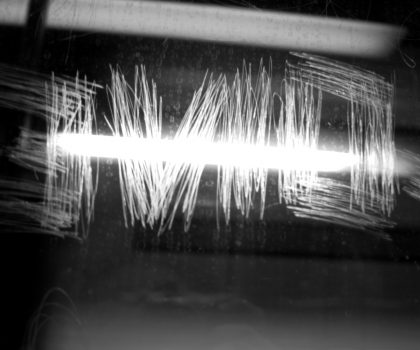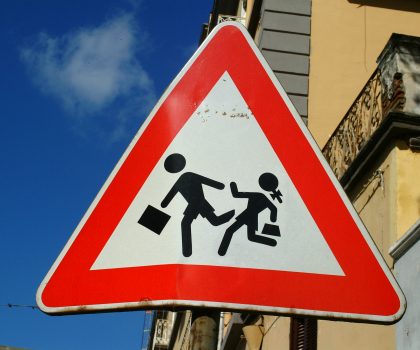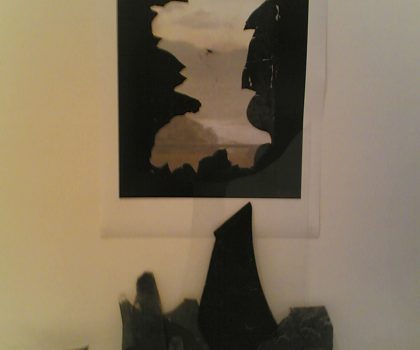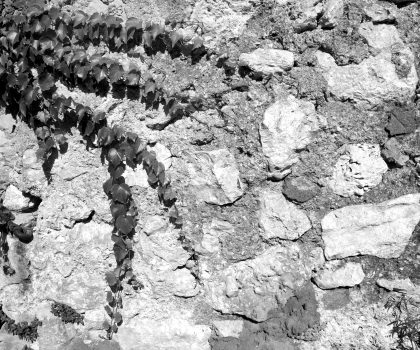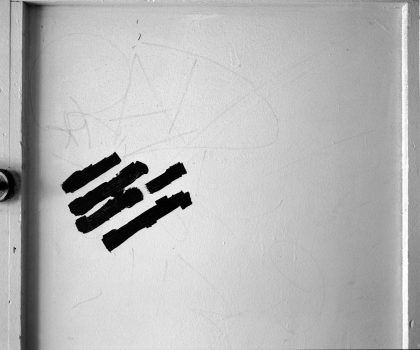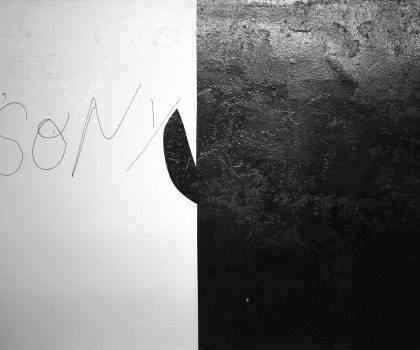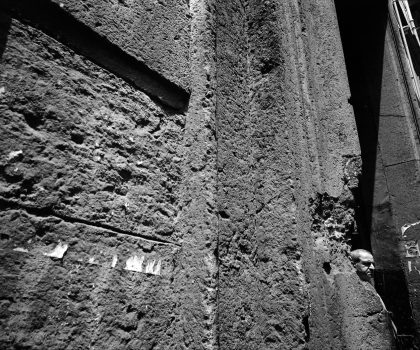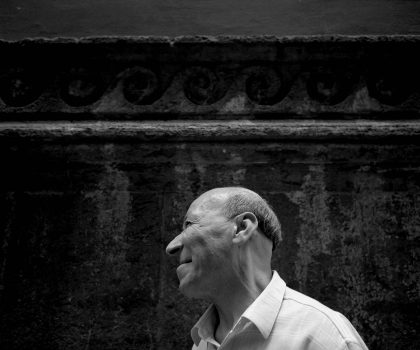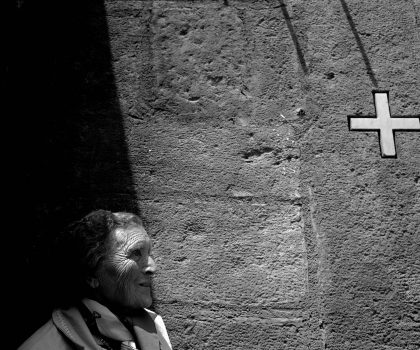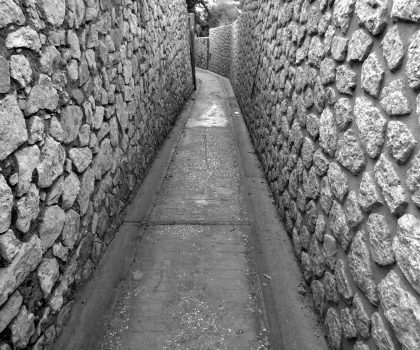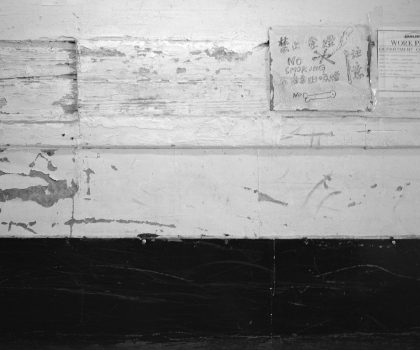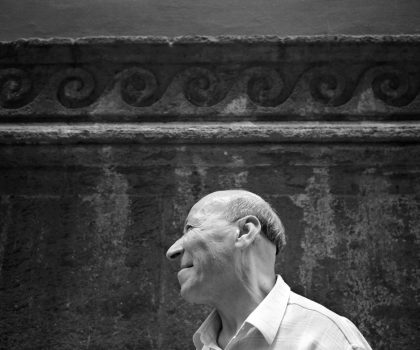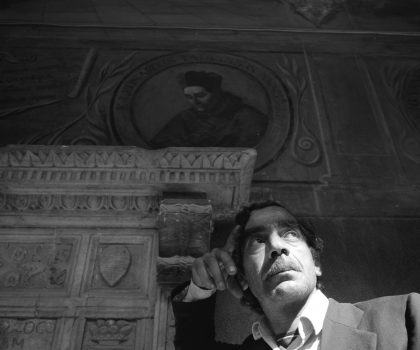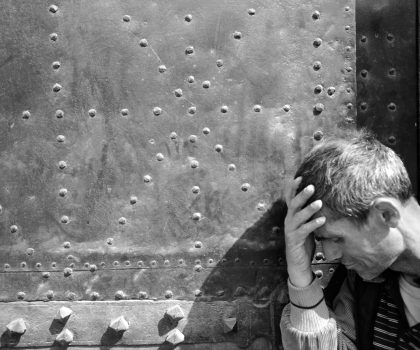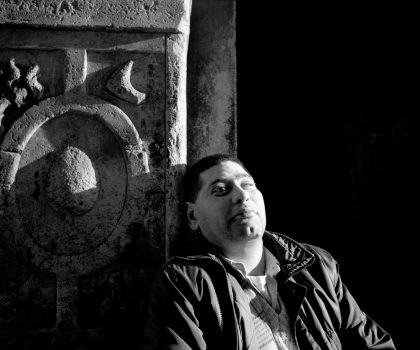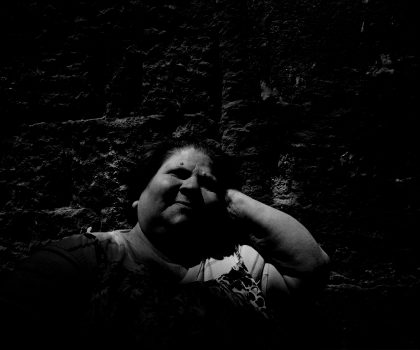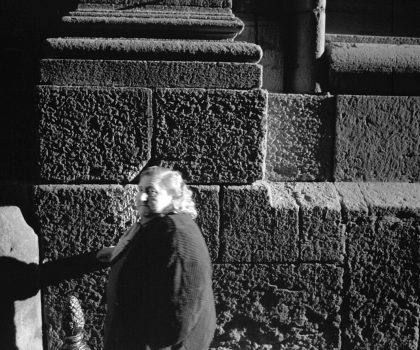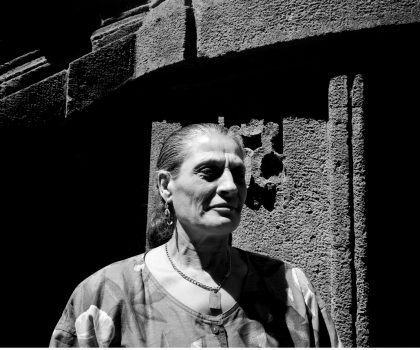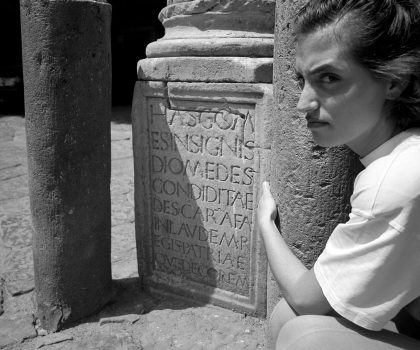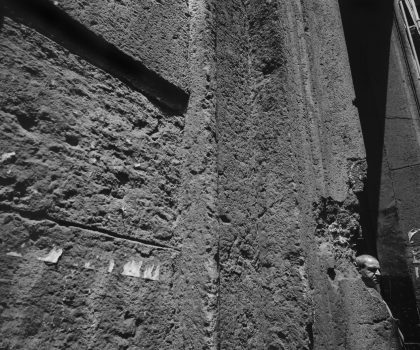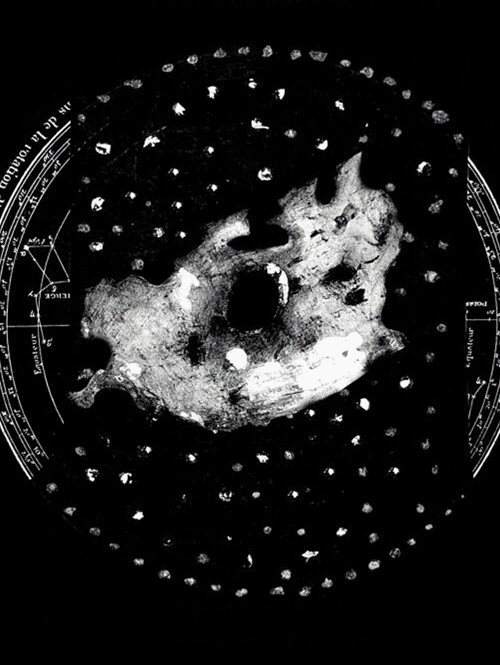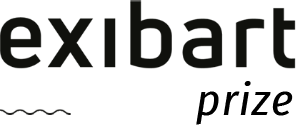THE COMPLEXION OF THE PIPERNO
"Carne di Piperno" is part of an artistic tradition that intertwines visual documentation and metaphorical speculation, building a dialogue between the inanimate matter of stone and the fragile temporality of human flesh. Taken in Naples, a city of contrasts and cultural stratifications, the images are structured around two key elements: the faces of the "neapolitans" on piperno walls, furrowed by signs of time and embellished with non-modern elements, lights and shadows. The title itself alludes to a fusion between organic and inorganic, between what is alive and what persists, evoking the eternal cycle of life and memory. The project stands out for its clever use of black and white, which is not a simple aesthetic expedient, but an interpretative key that amplifies the contrast between light and shadow, between the plasticity of the human face and the rough surface of piperno. The old woman is placed on the left of the frame, in a partially obscured area, as if emerging from a timeless shadow. The faces, often marked by deep wrinkles, are ideally reflected in the roughness of the stone, in a play of material resonances that underlines the analogy between skin and rock: both bear the signs of time, both tell sedimented stories.
Strong architectural symbolic elements are often positioned in an area of full light/shadow, almost as if to act as a symbolic counterpoint to the human figure. The piperno wall, with its porous texture and signs of erosion, becomes a metaphor for the city itself: Naples, which erodes and regenerates, which preserves the memory of those who have passed through it.
In the context of a photographic exhibition, "Carne di Piperno" can be read as a work that questions the relationship between body and space, between individual memory and collective memory. The choice to juxtapose the human figure with an architectural element is not accidental: the wall becomes a silent witness to history, an urban skin that dialogues with the lived skin of the woman portrayed. Curatorially, these images fit perfectly into an exhibition itinerary that investigates the theme of identity and permanence: the face of the "neapolitan" represents the living memory of the city, while the piperno tells a thousand-year-old story of construction and resistance and its gaze, turned towards the outside of the scene, suggests an opening, a continuity between past and future.
Photography could find space in exhibitions dedicated to the relationship between man and the city, to urban transformation, or to the cultural stratifications of Naples. It could be combined with works by Mimmo Jodice, who has often explored the theme of archaeological remains in relation to contemporary life, or inserted into a dialogue with artists who work on matter such as Alberto Burri, where the skin of the wall recalls the cracks of his Cretto.
From a sociological point of view, "Carne di Piperno" offers a reflection on the relationship between the individual and the urban context, between personal memory and collective history. Naples is a city that defines itself through its stratifications: every stone, every wall bears the signs of the generations that have lived there, just as the faces of its inhabitants tell stories of resistance, survival and transformation.
The protagonists of the photographs embody the historical memory of the city, a memory that is not only written in books, but is lived in the bodies, gestures, and expressions of those who live there. Their presence in the images suggests a Naples that is not only a city-museum, but a living organism, which feeds on the past to project itself into the future.
Piperno, a material widely used in Neapolitan architecture, here becomes a symbol of continuity. It is the stone of churches, noble palaces, but also of streets and alleys, and in these images it takes on an almost anthropological value: it is the "flesh" of the city, an urban fabric that breathes, that wears out but resists.
Last but not least, it suggests a reflection on the spirituality rooted in Neapolitan daily life. Faith in Naples is never just transcendence, but is incorporated into urban spaces, votive shrines, and symbols that dot the city and seems to want to establish a point of reference in a world in constant transformation.
"Carne di Piperno" is a work that lives on its interpretative ambiguity: it is a human portrait and an urban landscape at the same time, it is a reflection on matter and an investigation into the transience of life. Its strength lies in its ability to synthesize, in a single shot, the complex dialectic between what is ephemeral and what is eternal, between the skin of the living and the skin of the city. In the context of an exhibition, these images lend themselves to multiple readings and connections, becoming not only a single "photographic work", but a fragment of a broader discourse on memory, resistance and the human condition. The representation, therefore, of that photography that asks to be looked at carefully, because within its shadows and its lights resonate centuries of history and life resonate.
Strong architectural symbolic elements are often positioned in an area of full light/shadow, almost as if to act as a symbolic counterpoint to the human figure. The piperno wall, with its porous texture and signs of erosion, becomes a metaphor for the city itself: Naples, which erodes and regenerates, which preserves the memory of those who have passed through it.
In the context of a photographic exhibition, "Carne di Piperno" can be read as a work that questions the relationship between body and space, between individual memory and collective memory. The choice to juxtapose the human figure with an architectural element is not accidental: the wall becomes a silent witness to history, an urban skin that dialogues with the lived skin of the woman portrayed. Curatorially, these images fit perfectly into an exhibition itinerary that investigates the theme of identity and permanence: the face of the "neapolitan" represents the living memory of the city, while the piperno tells a thousand-year-old story of construction and resistance and its gaze, turned towards the outside of the scene, suggests an opening, a continuity between past and future.
Photography could find space in exhibitions dedicated to the relationship between man and the city, to urban transformation, or to the cultural stratifications of Naples. It could be combined with works by Mimmo Jodice, who has often explored the theme of archaeological remains in relation to contemporary life, or inserted into a dialogue with artists who work on matter such as Alberto Burri, where the skin of the wall recalls the cracks of his Cretto.
From a sociological point of view, "Carne di Piperno" offers a reflection on the relationship between the individual and the urban context, between personal memory and collective history. Naples is a city that defines itself through its stratifications: every stone, every wall bears the signs of the generations that have lived there, just as the faces of its inhabitants tell stories of resistance, survival and transformation.
The protagonists of the photographs embody the historical memory of the city, a memory that is not only written in books, but is lived in the bodies, gestures, and expressions of those who live there. Their presence in the images suggests a Naples that is not only a city-museum, but a living organism, which feeds on the past to project itself into the future.
Piperno, a material widely used in Neapolitan architecture, here becomes a symbol of continuity. It is the stone of churches, noble palaces, but also of streets and alleys, and in these images it takes on an almost anthropological value: it is the "flesh" of the city, an urban fabric that breathes, that wears out but resists.
Last but not least, it suggests a reflection on the spirituality rooted in Neapolitan daily life. Faith in Naples is never just transcendence, but is incorporated into urban spaces, votive shrines, and symbols that dot the city and seems to want to establish a point of reference in a world in constant transformation.
"Carne di Piperno" is a work that lives on its interpretative ambiguity: it is a human portrait and an urban landscape at the same time, it is a reflection on matter and an investigation into the transience of life. Its strength lies in its ability to synthesize, in a single shot, the complex dialectic between what is ephemeral and what is eternal, between the skin of the living and the skin of the city. In the context of an exhibition, these images lend themselves to multiple readings and connections, becoming not only a single "photographic work", but a fragment of a broader discourse on memory, resistance and the human condition. The representation, therefore, of that photography that asks to be looked at carefully, because within its shadows and its lights resonate centuries of history and life resonate.
Salvatore Sparavigna, born in Naples, is a visual storyteller whose career spans over forty years of photojournalism, art, and civic engagement, weaving together narratives that fuse the rawness of reality with the poetry of imagery. A photographer, videomaker, journalist, and EU project designer, his work is a mosaic of cultural identities, social struggles, and artistic experimentation—rooted in Southern Italy yet reaching toward global horizons.
From Beginnings to Photojournalistic Excellence
His journey began in 1980 in the alleys of Naples, where, as a freelance photographer, he documented local news and social customs for regional publications. A major turning point came in 1986 with the founding of FO.R.N.ASS. (Photographers & Reporters of Naples Associated), the first photojournalism agency in Campania. This agency became a beacon for portraying Southern Italy beyond stereotypes. His images, published in L’Espresso and Il Venerdì di Repubblica, capture not only events but the very soul of the territory: from juvenile delinquency to the fight against the Camorra, every shot becomes a manifesto of truth. In the 1990s, his gaze expanded to Europe, working with international magazines and agencies. In 1997, he anticipated the digital revolution with Napoli Live Web News, one of Italy’s first multimedia news platforms.
Art as Protest, Identity as Mission
For Sparavigna, photography is not just a profession but a universal language. In his artistic projects, he bridges past and present: Carne di Piperno (1990–2005) overlays contemporary portraits with architectural remnants, creating a dialogue between eras. Meanwhile, Le pose del caffè a… (2003–2006, leposedelcaffe.org) transforms the espresso cup into a symbol of belonging, capturing subjects from Naples to New York in moments of intimate reflection. In 2007, at the invitation of the City of New York, he brought Faces of ItaliaNY to the U.S.—an exhibition celebrating Italian-American roots through faces and rituals, from Brooklyn’s processions to Manhattan’s elegant parlors.
Social Cinema and WebTV: Giving Voice to the Invisible
His civic commitment found expression in social cinema through documentaries that lay bare social wounds. A camorra… song io? (2009), premiered in Casal di Principe during the National Day of Remembrance for Mafia Victims, exposes the silent complicity of Neapolitan society. Le rughe del tempo (2014) blends archival footage and contemporary landscapes to revive collective memory. In 2010, he founded La mia strada TV, Southern Italy’s first webTV dedicated to marginalized communities: from reports on the homeless to live broadcasts from school workshops, he transforms digital media into an instrument of inclusion.
EU Project Design and Education: Building the Future
Alongside his artistic practice, Sparavigna cultivates a strategic vision. Since 2019, as a Social Change Manager and EU project designer, he has developed innovation pathways for Third Sector organizations, managing European funding and coordinating initiatives such as the New Agenda for the Mediterranean. In classrooms from Naples to Torre Annunziata, he teaches young people how to use cameras and social media as tools for awareness, leading projects like TV a colori (2019), where students become webTV creators. Recent certifications in Artificial Intelligence for the Third Sector (2024) and Tourism Management reflect an ever-curious and evolving intellect.
Exhibitions and Awards: The Legacy of a Visionary
His works have traveled from the PAN (Palazzo delle Arti Napoli) to the Italian American Museum in New York, and to international festivals. Exhibitions like Adolescence: What Future? (1996–2000), shown in Florence and Naples, or Emergency Room (2009), featuring burned windows symbolizing extortion, are silent cries against indifference. Among his accolades are the Golden Lion (2018) for social commitment and the Lifetime Achievement Award (2013) from the VerbinalandrArt Association—tributes to an artist who has turned photography into a political act.
Technique and Heart: The Duality of an Artist
A master of editing software and copyright law, Sparavigna handles both analog and digital languages with equal finesse. His images, often in black and white, play with dramatic contrasts and urban geometries, while his videos combine cinematic aesthetics with documentary rhythm. But humanity is the true common thread: behind every project lies a question, a challenge, an invitation to look beyond appearances.
Today, between consultancy work for Getty Images and multisensory exhibitions such as DECUMANI – Voices from the Heart of Naples (2017), Salvatore Sparavigna embodies the role of the engagé artist: a bridge between art and society, memory and innovation—proving that beauty can emerge from commitment.
From Beginnings to Photojournalistic Excellence
His journey began in 1980 in the alleys of Naples, where, as a freelance photographer, he documented local news and social customs for regional publications. A major turning point came in 1986 with the founding of FO.R.N.ASS. (Photographers & Reporters of Naples Associated), the first photojournalism agency in Campania. This agency became a beacon for portraying Southern Italy beyond stereotypes. His images, published in L’Espresso and Il Venerdì di Repubblica, capture not only events but the very soul of the territory: from juvenile delinquency to the fight against the Camorra, every shot becomes a manifesto of truth. In the 1990s, his gaze expanded to Europe, working with international magazines and agencies. In 1997, he anticipated the digital revolution with Napoli Live Web News, one of Italy’s first multimedia news platforms.
Art as Protest, Identity as Mission
For Sparavigna, photography is not just a profession but a universal language. In his artistic projects, he bridges past and present: Carne di Piperno (1990–2005) overlays contemporary portraits with architectural remnants, creating a dialogue between eras. Meanwhile, Le pose del caffè a… (2003–2006, leposedelcaffe.org) transforms the espresso cup into a symbol of belonging, capturing subjects from Naples to New York in moments of intimate reflection. In 2007, at the invitation of the City of New York, he brought Faces of ItaliaNY to the U.S.—an exhibition celebrating Italian-American roots through faces and rituals, from Brooklyn’s processions to Manhattan’s elegant parlors.
Social Cinema and WebTV: Giving Voice to the Invisible
His civic commitment found expression in social cinema through documentaries that lay bare social wounds. A camorra… song io? (2009), premiered in Casal di Principe during the National Day of Remembrance for Mafia Victims, exposes the silent complicity of Neapolitan society. Le rughe del tempo (2014) blends archival footage and contemporary landscapes to revive collective memory. In 2010, he founded La mia strada TV, Southern Italy’s first webTV dedicated to marginalized communities: from reports on the homeless to live broadcasts from school workshops, he transforms digital media into an instrument of inclusion.
EU Project Design and Education: Building the Future
Alongside his artistic practice, Sparavigna cultivates a strategic vision. Since 2019, as a Social Change Manager and EU project designer, he has developed innovation pathways for Third Sector organizations, managing European funding and coordinating initiatives such as the New Agenda for the Mediterranean. In classrooms from Naples to Torre Annunziata, he teaches young people how to use cameras and social media as tools for awareness, leading projects like TV a colori (2019), where students become webTV creators. Recent certifications in Artificial Intelligence for the Third Sector (2024) and Tourism Management reflect an ever-curious and evolving intellect.
Exhibitions and Awards: The Legacy of a Visionary
His works have traveled from the PAN (Palazzo delle Arti Napoli) to the Italian American Museum in New York, and to international festivals. Exhibitions like Adolescence: What Future? (1996–2000), shown in Florence and Naples, or Emergency Room (2009), featuring burned windows symbolizing extortion, are silent cries against indifference. Among his accolades are the Golden Lion (2018) for social commitment and the Lifetime Achievement Award (2013) from the VerbinalandrArt Association—tributes to an artist who has turned photography into a political act.
Technique and Heart: The Duality of an Artist
A master of editing software and copyright law, Sparavigna handles both analog and digital languages with equal finesse. His images, often in black and white, play with dramatic contrasts and urban geometries, while his videos combine cinematic aesthetics with documentary rhythm. But humanity is the true common thread: behind every project lies a question, a challenge, an invitation to look beyond appearances.
Today, between consultancy work for Getty Images and multisensory exhibitions such as DECUMANI – Voices from the Heart of Naples (2017), Salvatore Sparavigna embodies the role of the engagé artist: a bridge between art and society, memory and innovation—proving that beauty can emerge from commitment.



